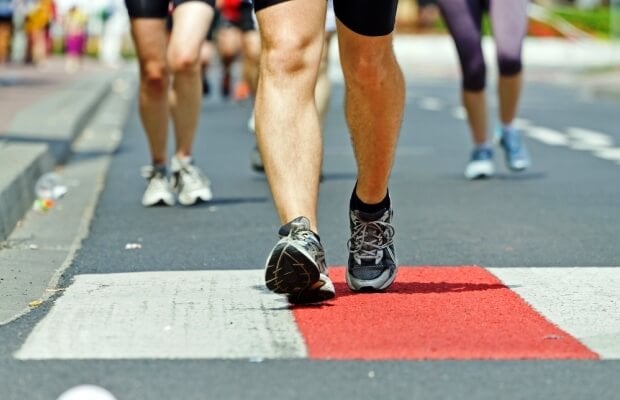If sport has been a part of your life, either continuously or intermittently over the past 30 or 40 years, by now parts of you may be hurting. It might be knees or hips or ankles, or just a general ache somewhere across your back.
Trainers? We had green flash gym shoes or running shoes with minimal support. No wonder our joints are worn. Warm up? We touched our toes and headed into combat. Warm down? What’s that? The final whistle’s gone and the bar’s that way.
The blissful ignorance of those pre-sports science days has come back to bite us as we consider continuing or resuming our careers in the walking sport arena.
The beauty of walking sports is that you play on your terms and, most importantly, have fun along the way! By all means, throw on your comfiest trainers and use jumpers as goalposts if you like. To ensure the fun and fitness doesn’t stop though, it’s worth being mindful of how you’re preparing for exercise and pacing yourself. While what you’re about to undertake is nothing nearly as strenuous as in days gone by, walking sports will work the muscles a little harder than we’re used to. Let’s be sensible, so aches are minimal and we can play again as soon as possible.
Consult your coach
There’s no need to put pressure on yourself to undertake a rigorous warm-up or cool down routine. Joining a walking sports team should be relaxed, free-flowing and enjoyable every step of the way. Your coach will most likely lead an easy, informal warm-up like a walk around the pitch, followed by light stretching to cool down. Be sure to get to the venue 15 minutes before you need to. If you’re rushing, the first thing to get jettisoned is the warm-up – not forgetting that friendly ‘hello’ and catch-up with your friends. If you’d like to do a little extra moving before or after a session, ask your coach for tips. They might mention the following:
Gentle stretching
Do this while you’re standing up and then lying down. No-one’s going to laugh at you. This is a major act of self-preservation. The purpose of stretching to get muscles working and loose. You don’t expect a car to go from a standing start to 70 mph in a couple of seconds, so why place similar expectations and pressure on your body?
After all, when your body is resting, only 20% of your total blood volume is in the muscles, while the rest resides in the organs. However, during exercise, as much as 80% of your blood is in the muscles. Warming up gives the body a chance to move the blood into your muscles where it can provide oxygen and nutrients. That’s why dynamic movement is key. Walking some, or all, of the way to a session could make a real difference to how you feel too. A bit of jogging, and faster limb movement across 10 minutes gets the heartbeat up and prepares you for the fun to come. It’s less enjoyable honestly, if you’re feeling stiff as a board when you start. I know that’s what it was like in the old days, but that’s precisely the point.
Take it easy
Crucially, you should not feel any pain while warming up. If you do, go slower. Each moment should be smooth and gentle, not fast or jerky. Walking sports offer a less strenuous form of exercise, but remain a fantastic workout that gets the heart pumping, strengthens muscles and keeps the mind active. Therefore, preparing your body shouldn’t be knackering. You’re simply getting your body used to movement.
Cool down slowly and carefully
You play, you laugh, and you sweat a bit (or maybe you don’t) and before you know it the session is over.
And then you don’t instantly head for the bar, the coffee shop or the changing rooms (good things come to those who wait!). You cool down. Stretch. Gently. Repeat. You adapt your body from the exertions of walking sport to the inertia of sitting down with a cuppa or a pint.
Every minute you spend helping your body to cope with the stresses and strains of physical activity is time well spent. Again, think of yourself as that car – specifically, which parts of you need oiling before and after. You don’t want to exacerbate any injuries you already have, and a pre and post sport routine will help prolong your sporting career even more.
Look at it this way. Put your back in to preparing properly and you’re much less likely to put your back out when it comes to doing anything.
If only we’d known then what we know now.

